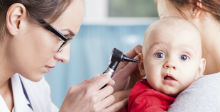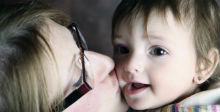Internal mini form
Contact Us Today
Children with Cerebral Palsy are at risk for developing skin conditions due to the nature, care, and the treatment of their impairments. Skin conditions include minor skin inflammation, allergic reactions to medications, skin irritations from frequent rubbing, scars from surgical procedures, and self-injury – whether voluntary or involuntary.
What is the difference between infectious and non-infectious skin conditions?
Skin conditions are either non-infectious or infectious.
Non-infectious skin conditions
Non-infectious skin conditions cannot be spread from one person to another. They include problems caused by adaptive equipment, accidents, trauma, or self-injury, mostly associated with events specific to the individual’s impairment and associative conditions.
For example:
- Vision impairment – Those with vision loss are more likely to bump into objects they cannot see and therefore have more propensity for traumatic scarring.
- Hearing impairment – Those with hearing loss may walk into the path of vehicles they do not sense, making them more prone to accidents.
- Intellectual impairment – Those with intellectual impairment are more likely to exhibit self-injurious behavior.
- Assistive services and technologies – Those with more rigorous physical therapy or ill-fitting adaptive equipment may have more callus formations where the skin repetitively rubs against clothing or equipment.
- Oral motor dysfunction – Individuals that experience excessive drooling from oral motor dysfunction may be vulnerable to non-infectious skin irritations, as well.
Infectious skin conditions
Infectious skin conditions are communicable and can be spread to others.
There are four types of infectious skin conditions:
- Bacterial – occurs when the skin is irritated by scratching and itching, or a surgical wound becomes infected. Bacterial infections may involve boils, pimples, folliculitis, and impetigo. Staph infections (clinically referred to as staphylococcus) can spread infection throughout the body. MRSA (clinically referred to as methicillin-resistant staphylococcus aureaus) is a type of staph bacteria resistant to antibiotic treatment commonly used to treat other staph infections.
- Fungal – is inflammation from exposure to fungus, such as athlete’s foot, yeast infection, nail infection, or ringworm. Warm and moist skin is particularly susceptible to fungal infections.
- Parasitic – occurs when the skin encounters a parasite, such as head lice, dust mites, fleas, or scabies. Parasites can live on the skin (ectoparasites) or live inside the body (endoparasites). Some parasites reside in the gastrointestinal tract, a condition generally caused by poor hygiene or coming into contact with feces.
- Viral – infections caused by a virus within the body. A virus will infect body tissue, including the brain and skin. Viruses are fought by the body’s immune system and do not respond to antibiotic treatment.
Skin conditions can result from:
- genetic predisposition
- nutritional deficiencies
- vitamin deficiencies
- exposure to contagions
- poor hygiene
- constant irritation
Prevention measures to avoid skin conditions
It is recommended that children maintain healthy diets, exercise, wash, and adhere to healthy sleep routines. Measures should be taken to avoid accidents, irritation and self-inflicted injuries.
Prevention measures include:
- Moisturizing skin – Skin must be washed, moisturized, and kept dry.
- Washing hands – Hands should be washed often, especially after sneezing, coughing, toileting, play, and before meals.
- Cleansing hair – Hair should be washed and moisturized. Clothing should be washed and changed often.
- Trimming nails – Nails should be trimmed, and care should be taken to not use the same trimmers on abnormal nails.
- Maintaining orthotics – Orthotics and adaptive equipment should be properly washed, dried, positioned, and checked for proper fit.
- Positioning for circulation – If the child is not mobile, care must be taken to increase blood circulation through posture, positioning, and massage.
- Changing incontinence products timely – Diapers, under pads, or incontinence products must be changed often and checked for proper sizing.
- Freshening bedding – Bedding should be changed regularly. Bed sheets should be periodically checked for bed bugs or dust mites, hair checked for lice, and skin checked, particularly underarms, buttocks, groin, arms and legs for skin irritation.
- Checking for allergic reactions – Care should be taken to ensure the child does not have an allergic reaction to such things as deodorants, moisturizers, lotions, laundry detergent, fabric softeners, soaps, perfume, under pads, or medications.
- Sizing clothing properly – Clothing should not be too tight or too loose. Shoes should be checked for proper sizing.
- Keep open wounds clean – Scars, bed sores, pressure sores, surgical incisions, and wounds should be properly cared for.
Treatment options for skin conditions
The child’s primary care physician is the first line of defense against infections or skin conditions that are not easily treated by proper hygiene and over-the-counter topical medication. Your child may be referred to a dermatologist for skin conditions, gastroenterologist for intestinal concerns, or urologist (or gynecologist) for urinary tract infections or infections around genitalia.
Skin conditions include:
- Bacterial infection
- Boils
- Congenital skin conditions
- Folliculitis
- Fungal infection
- MRSA infection
- Nail infection
- Parasitic infection
- Pimples
- Pressure sores
- Psoriasis
- Ringworm
- Scabies
- Skin infections
- Skin irritation
- Skin ulcers
- Staph infection
- Viral infection
- Yeast infection

Associative conditions
Cerebral Palsy affects muscle tone, gross and fine motor functions, balance, coordination, and posture. These conditions are mainly orthopedic in nature and are considered primary conditions of Cerebral Palsy. There are associative conditions, like seizures and intellectual impairment that are common in individuals with Cerebral Palsy. And, there are co-mitigating factors that co-exist with Cerebral Palsy, but are unrelated to it. Understanding conditions commonly associated with Cerebral Palsy will enhance your ability to manage your child’s unique health concerns.
Associative Conditions
Common associative conditions
Click on a condition listed below to learn more.








